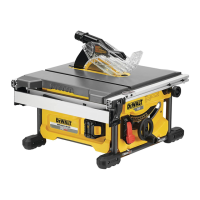19
ENGLISH
OPERATION
Instructions for Use
WARNING: Always observe the safety instructions and
applicableregulations.
WARNING: To reduce the risk of serious personal
injury, turn tool off and disconnect battery pack
before making any adjustments or removing/
installing attachments or accessories. An accidental
start-up can causeinjury.
The attention of UK users is drawn to the “woodworking machines
regulations 1974” and any subsequentamendments.
Ensure the machine is placed to satisfy your ergonomic
conditions in terms of table height and stability. The machine
site shall be chosen so that the operator has a good overview
and enough free surrounding space around the machine that
allows handling of the workpiece without anyrestrictions.
To reduce effects of increased vibration, make sure the
environment is not too cold, the machine and accessory are well
maintained and the workpiece size is suitable for thismachine.
WARNING:
• Always observe the safety instructions and
applicableregulations.
• Ensure the machine is placed to satisfy ergonomic
conditions in terms of table height and stability. The
machine site shall be chosen so that the operator
has a good overview and enough free surrounding
space around the machine that allow handling of the
workpiece without anyrestrictions.
• Install the appropriate saw blade. Do not use
excessively worn blades. The maximum rotation speed
of the tool must not exceed that of the sawblade.
• Do not attempt to cut excessively smallpieces.
• Allow the blade to cut freely. Do notforce.
• Allow the motor to reach full speed beforecutting.
• Make sure all locking knobs and clamp handles
aretight.
• Never place either hand in the blade area when the
saw is connected to the electrical powersource.
• Never use your saw for freehandcuts!
• Do not saw warped, bowed or cupped workpieces.
There must be at least one straight, smooth side to go
against the rip fence or mitrefence.
• Always support long workpieces to preventkickback.
• Do not remove any cut-offs from the blade area while
the blade isrunning.
Switching On and Off (Fig. A, M)
The on/off switch
8
(Fig. A) of your table saw offers multiple
advantages:
• No-volt release function: should the power be shut off for
any reason, the switch has to be deliberatelyreactivated.
• Lift the red paddle
41
and push green button
42
in to turn
this sawon.
• Push the red button
43
or push down the red paddle to
turn this sawoff.
Rip Fence Operation (Fig. A, N)
Rail Lock Lever
The rail lock lever
5
locks the fence in place preventing
movement during cutting. To lock the rail lever, push it down
and toward the rear of the saw. To unlock, pull it up and toward
the front of thesaw.
NOTE: When ripping, always lock the rail locklever.
Work Support Extension /Narrow Ripping
Fence
Your table saw is equipped with a work support extension to
support work that extends beyond the sawtable.
To use the narrow ripping fence in the work support position,
rotate it from its stored position as shown in FigureN, and
slide the pins into the lower sets of slots
44
on both ends of
thefence.
To use the narrow ripping fence in the narrow ripping position,
snap the pins into the upper sets of slots
45
on both ends of
the fence. This feature will allow 51mm of extra clearance to the
blade. Refer to FigureN.
NOTE: Retract the work support extension or adjust to narrow
rip fence position whenever working over thetable.
Fine Adjustment Knob
The fine adjustment knob
4
allows smaller adjustments when
setting the fence. Before adjusting, be sure the rail lock lever is in
its up or unlocked, position.
Rip Scale Pointer
The rip scale pointer will need to be adjusted for proper
performance of the rip fence if the user switches between thick
and thin kerf blades. The rip scale pointer only reads correctly
for position 1(0mm to 510mm), however for position 1 with
narrow rip fence in use add 52mm. See Adjusting the Rip Scale
underAssembly.
Basic Saw Cuts
Ripping (Fig. A, B, O)
WARNING: Sharpedges.
1. Set the blade to 0°.
2. Lock the rip fence latch
19
(Fig.A).
3. Raise the blade until it is about 3 mm higher than the top of
the workpiece.
4. Adjust the position of the fence, refer to Rip
FenceOperation.
5. Hold the workpiece flat on the table and against the fence.
Keep the workpiece away from theblade.
6. Keep both hands away from the path of the blade(Fig.O).
Ташев-Галвинг ООД
www.tashev-galving.com

